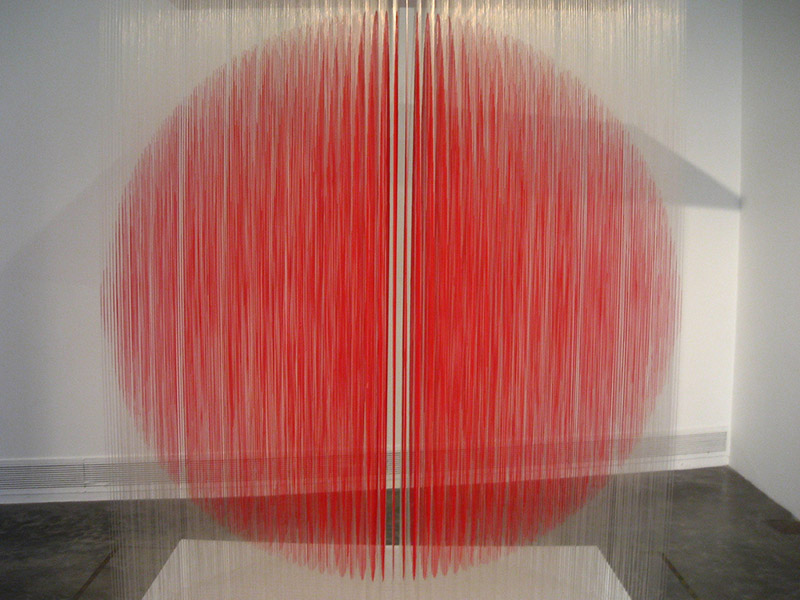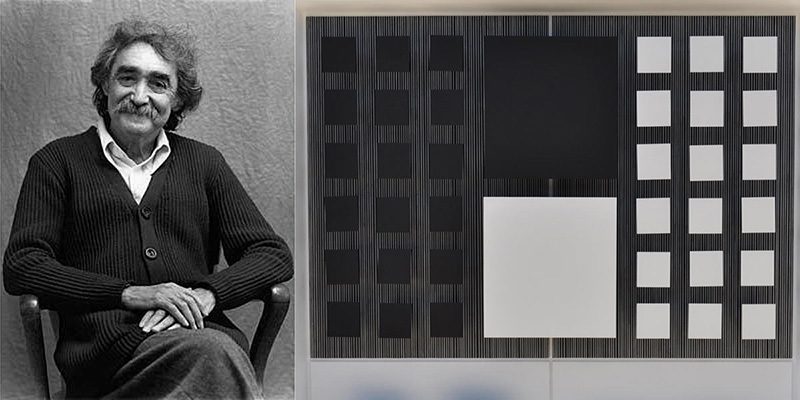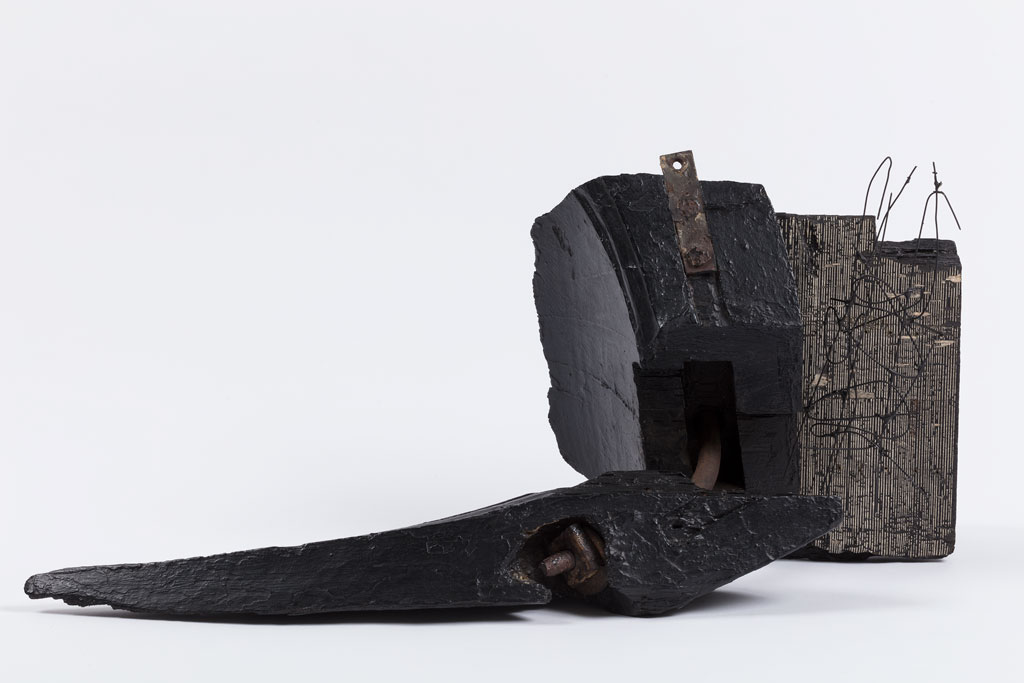TRACES: Jesús Rafael Soto
 Today is the occasion to bear in mind Jesús Rafael Soto (5/6/1923-14/1/2005). Soto’s work is characterized by optical illusions and movement making him one of the most accomplished artists within the Op Art and Kinetic Art Movement. The symbolism of energy is evident in Soto’s works, which make them more than mere pieces optical illusion but works of art that use optical effects and kinetic movement to represent the concentration of energy. Through documents or interviews, starting with: moments and memories, we reveal out from the past-unknown sides of big personalities, who left their indelible traces in time and history…
Today is the occasion to bear in mind Jesús Rafael Soto (5/6/1923-14/1/2005). Soto’s work is characterized by optical illusions and movement making him one of the most accomplished artists within the Op Art and Kinetic Art Movement. The symbolism of energy is evident in Soto’s works, which make them more than mere pieces optical illusion but works of art that use optical effects and kinetic movement to represent the concentration of energy. Through documents or interviews, starting with: moments and memories, we reveal out from the past-unknown sides of big personalities, who left their indelible traces in time and history…
By Efi Michalarou
 Jesús Rafael Soto was born in Ciudad Bolívar, Venezuela in 1923. As a boy Soto was extremely taken with art and he started his career young by painting movie posters in his native city. Soto studied art at the Escuela de Artes Plásticas y Artes Aplicadas in Caracas, Venezuela. While he was a student Soto regularly met fellow students, at an open air studio financed by the ministry of education to discuss avant-garde concepts from Europe and Latin America. Then served as director of the Escuela de bellas artes in Maracaibo, Venezuela, until 1950, at which time he moved to Paris. There he associated with Yaacov Agam, Jean Tinguely, and Victor Vasarely, as well as artists connected to Galerie Denise René and the “Nouveau Réalisme”. Having started out as an illusionistic painter, in 1955 Soto participated in “Le movement” at Galerie Denise René, the exhibition that effectively launched Kinetic Art. Around this time, and for many years subsequently, Soto’s art oscillated between geometric and organic forms. His work is often associated with Venezuelan Op Art because the serial geometric forms of his paintings of the ‘50s bear an affinity to works from that later movement. By 1957 Soto had moved toward a more gestural abstraction, but by 1965 he had returned definitively to a geometric idiom. During the same decade, he began making linear, kinetic constructions using industrial and synthetic materials such as nylon, Perspex, steel, and industrial paint. By the ‘60s, Soto was exclusively working with lines and movement having abandoned color. Soto created pieces called “Penetrables”, which were interactive pieces of art using metal and plastic. They contained of square structures from which thin tubes dangles and spectators could walk through these sculptures. Soto made over 25 of these sculptures during the span of his career. It said of Soto’s work that it is inseparable from the interaction that it has with the viewer. The period 1965-1979, major exhibitions of Soto’s work took place at Signals Gallery, Museum of Contemporary Art in Chicago, Solomon R. Guggenheim Museum in New York and Centre Georges Pompidou. For each of these exhibitions, Soto used swaying nylon thread or plastic string to turn the gallery space into an all-encompassing, kinetic installation, in which the experience of the spectator within the constructed environment was central to the work’s meaning. Soto’s sculptures and environments often play with the juxtaposition of solid and void, deliberately unsettling the act of viewing by blurring the distinction between reality and illusion. In 1969 UNESCO commissioned Soto to create two murals for their buildings in Paris. Over the next few decades, several more commissions followed, including two in his native Venezuela. In 1973 the Museo de arte moderno Jesús Soto, which houses works by Soto along with works by international avant-garde artists he admired, including: Jean Arp, Kazimir Malevich, and Man Ray, opened in his birth city of Ciudad Bolívar. Soto died in Paris in 2005 and is buried in the Cimetière de Montparnasse.
Jesús Rafael Soto was born in Ciudad Bolívar, Venezuela in 1923. As a boy Soto was extremely taken with art and he started his career young by painting movie posters in his native city. Soto studied art at the Escuela de Artes Plásticas y Artes Aplicadas in Caracas, Venezuela. While he was a student Soto regularly met fellow students, at an open air studio financed by the ministry of education to discuss avant-garde concepts from Europe and Latin America. Then served as director of the Escuela de bellas artes in Maracaibo, Venezuela, until 1950, at which time he moved to Paris. There he associated with Yaacov Agam, Jean Tinguely, and Victor Vasarely, as well as artists connected to Galerie Denise René and the “Nouveau Réalisme”. Having started out as an illusionistic painter, in 1955 Soto participated in “Le movement” at Galerie Denise René, the exhibition that effectively launched Kinetic Art. Around this time, and for many years subsequently, Soto’s art oscillated between geometric and organic forms. His work is often associated with Venezuelan Op Art because the serial geometric forms of his paintings of the ‘50s bear an affinity to works from that later movement. By 1957 Soto had moved toward a more gestural abstraction, but by 1965 he had returned definitively to a geometric idiom. During the same decade, he began making linear, kinetic constructions using industrial and synthetic materials such as nylon, Perspex, steel, and industrial paint. By the ‘60s, Soto was exclusively working with lines and movement having abandoned color. Soto created pieces called “Penetrables”, which were interactive pieces of art using metal and plastic. They contained of square structures from which thin tubes dangles and spectators could walk through these sculptures. Soto made over 25 of these sculptures during the span of his career. It said of Soto’s work that it is inseparable from the interaction that it has with the viewer. The period 1965-1979, major exhibitions of Soto’s work took place at Signals Gallery, Museum of Contemporary Art in Chicago, Solomon R. Guggenheim Museum in New York and Centre Georges Pompidou. For each of these exhibitions, Soto used swaying nylon thread or plastic string to turn the gallery space into an all-encompassing, kinetic installation, in which the experience of the spectator within the constructed environment was central to the work’s meaning. Soto’s sculptures and environments often play with the juxtaposition of solid and void, deliberately unsettling the act of viewing by blurring the distinction between reality and illusion. In 1969 UNESCO commissioned Soto to create two murals for their buildings in Paris. Over the next few decades, several more commissions followed, including two in his native Venezuela. In 1973 the Museo de arte moderno Jesús Soto, which houses works by Soto along with works by international avant-garde artists he admired, including: Jean Arp, Kazimir Malevich, and Man Ray, opened in his birth city of Ciudad Bolívar. Soto died in Paris in 2005 and is buried in the Cimetière de Montparnasse.















